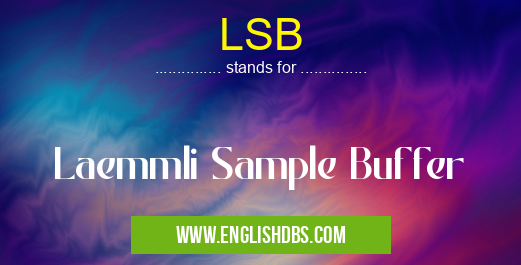What does LSB mean in UNCLASSIFIED
Laemmli Sample Buffer (LSB) is a key component in sodium dodecyl sulfate-polyacrylamide gel electrophoresis (SDS-PAGE), a technique widely used to separate proteins based on their size and charge.

LSB meaning in Unclassified in Miscellaneous
LSB mostly used in an acronym Unclassified in Category Miscellaneous that means Laemmli Sample Buffer
Shorthand: LSB,
Full Form: Laemmli Sample Buffer
For more information of "Laemmli Sample Buffer", see the section below.
Definition of LSB
LSB is a buffer solution used to prepare protein samples for SDS-PAGE. It typically contains:
- Tris-HCl: A buffering agent that maintains the pH of the sample.
- Sodium dodecyl sulfate (SDS): A detergent that denatures proteins, breaking down their secondary and tertiary structures.
- Glycerol: A viscous liquid that helps load the sample onto the gel.
- Bromophenol blue: A dye that aids in visualizing the sample during electrophoresis.
- β-mercaptoethanol: A reducing agent that breaks disulfide bonds in proteins.
Role of LSB
LSB plays a crucial role in SDS-PAGE by:
- Denaturing proteins: SDS disrupts the non-covalent bonds holding proteins together, unfolding them and giving them a uniform negative charge.
- Reducing disulfide bonds: β-mercaptoethanol breaks down disulfide bonds, ensuring that proteins are fully denatured and linear.
- Providing a uniform charge: The negative charge imparted by SDS allows proteins to migrate through the gel during electrophoresis based solely on their size.
- Facilitating sample loading: Glycerol increases the density of the sample, making it easier to load onto the gel.
Essential Questions and Answers on Laemmli Sample Buffer in "MISCELLANEOUS»UNFILED"
What is Laemmli Sample Buffer (LSB)?
LSB is a buffer solution used in protein electrophoresis, specifically in sodium dodecyl sulfate-polyacrylamide gel electrophoresis (SDS-PAGE). It is used to prepare protein samples for electrophoresis and contains components that assist in protein denaturation, reduction, and binding to the gel.
What are the components of LSB?
LSB typically consists of the following components:
- Tris-HCl buffer: Provides the pH environment for the buffer.
- Sodium dodecyl sulfate (SDS): A detergent that denatures and unfolds proteins.
- Dithiothreitol (DTT): A reducing agent that breaks disulfide bonds in proteins.
- Glycerol: Increases the density of the buffer, helping to load samples onto the gel.
- Bromophenol blue: A tracking dye used to visualize the progress of the electrophoresis.
Why is SDS used in LSB?
SDS is used in LSB because it denatures proteins by breaking non-covalent bonds and unfolding them. This allows all proteins to have a uniform negative charge and migrate at a rate proportional to their size in SDS-PAGE.
What is the role of DTT in LSB?
DTT is used in LSB as a reducing agent to break disulfide bonds between cysteine residues in proteins. This helps to unfold proteins completely and ensure even migration during electrophoresis.
How is LSB used to prepare protein samples for electrophoresis?
LSB is mixed with protein samples in a ratio typically ranging from 1:1 to 1:5 (protein:LSB). The mixture is then heated to a specific temperature (usually 95-100°C) for a few minutes to ensure complete denaturation and unfolding of the proteins. The heated samples are then loaded onto the electrophoresis gel.
Final Words: LSB is a critical reagent in SDS-PAGE, enabling the separation and analysis of proteins. It denatures proteins, reduces disulfide bonds, and provides a uniform charge, ensuring accurate and reproducible results in protein electrophoresis.
LSB also stands for: |
|
| All stands for LSB |
